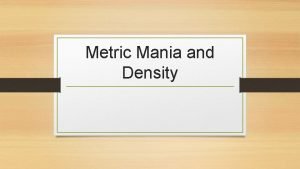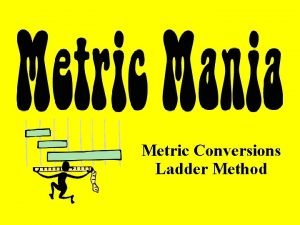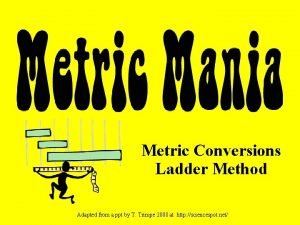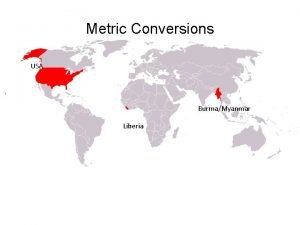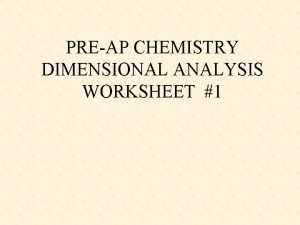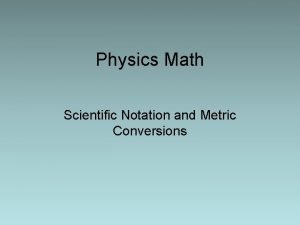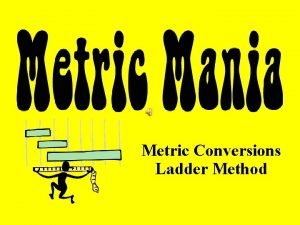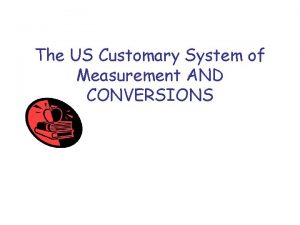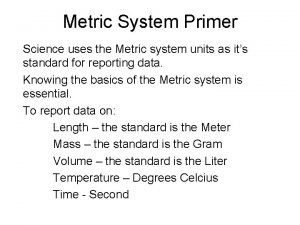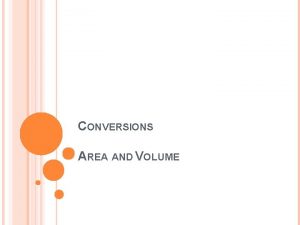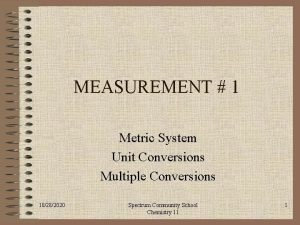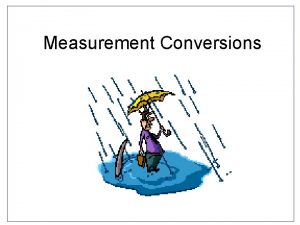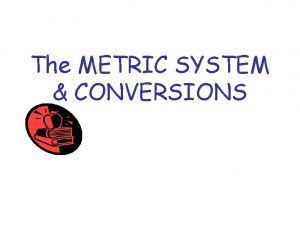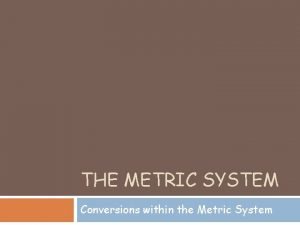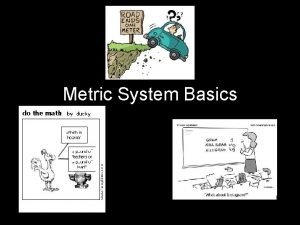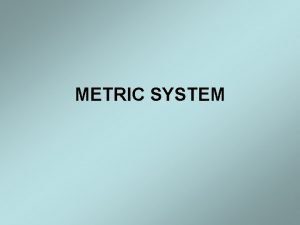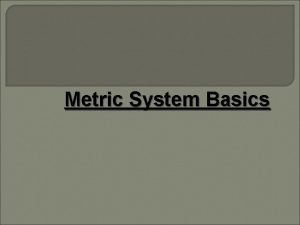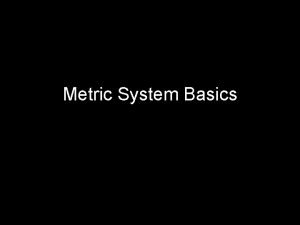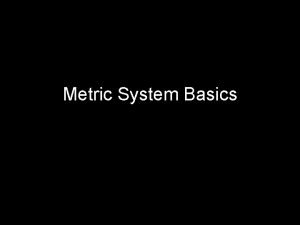The METRIC SYSTEM CONVERSIONS The Metric System The
















- Slides: 16

The METRIC SYSTEM & CONVERSIONS

The Metric System • The metric system is an internationally standardized system of units of measurement. • The metric system is based on a base unit and prefixes.

Prefixes • • Kilo Hecto Deca Deci Centi Milli - 1000 10 1 0. 01 0. 001 k h da d c m

Length • The basic unit of length in the metric system is the meter (m) • Metric Units of Length – – – – Kilometer (km) = 1000 m Hectometer (hm) = 100 m Decameter (dam) = 10 m Meter (m) = 1 m Decimeter (dm) = 0. 1 m Centimeter (cm) = 0. 01 m Millimeter (mm) = 0. 001 m

When working with customary units of measurement, to change from larger to smaller units you multiplied. To change from smaller units to larger units, you divided. Do you think the same rules apply to metric? Why?

Length • The basic unit of length in the metric system is the meter (m) • Metric Units of Length – – – – Kilometer (km) = 1000 m Hectometer (hm) = 100 m Decameter (dam) = 10 m Meter (m) = 1 m Decimeter (dm) = 0. 1 m Centimeter (cm) = 0. 01 m Millimeter (mm) = 0. 001 m

Capacity • Liquid substances are measured in units of capacity. • The basic unit of mass in the metric system is a liter (L) • 1 L = capacity of a cube that measures 10 cm x 10 cm • Metric Units of Capacity – – – – Kiloliter (k. L) = 1000 L Hectoliter (h. L) = 100 L Decaliter (da. L) = 10 L Liter (L) = 1 L Deciliter (d. L) = 0. 1 L Centiliter (c. L) = 0. 01 L Milliliter (m. L) = 0. 001 L

Mass • Weight is a measure of how strongly gravity is pulling on an object (decreases as elevation increases) • Mass is the amount of material in an object (doesn’t change) • Note: on Earth, weight and mass are used interchangeably

Mass • The basic unit of mass in the metric system is a gram (g) • 1 g = mass of water in a cube that measures 1 cm x 1 cm • Metric Units of Mass – – – – Kilogram (kg) = 1000 g Hectogram (hg) = 100 g Decagram (dag) = 10 g Gram (g) = 1 g Decigram (dg) = 0. 1 g Centigram (cg) = 0. 01 g Milligram (mg) = 0. 001 g

Conversions within the Metric System • To convert units within the metric system, write the prefixes in order from largest to smallest k h da d c m • To convert from a smaller unit to a larger unit, move to the left • To convert from a larger unit to a smaller unit, move to the right

Ex: Convert 1600 cm to m • km hm dam m dm cm mm • Move 2 places to the left to get from cm to m • Therefore, move the decimal point in 1600 two places to the left to convert from cm to m Ø 1600 cm = 16. 00 m

Ex: Convert 2 k. L to L • k. L h. L da. L L d. L c. L m. L • Move 3 places to the right to get from k. L to L • Therefore, move the decimal point in 2 three places to the right to convert from k. L to L Ø 2 KL = 2000 L

Ex: Convert 241 g to mg • kg hg dag g dg cg mg • Move 3 places to the right to get from g to mg • Therefore, move the decimal point in 241 three places to the right to convert from g to mg Ø 241 g = 241, 000 mg

Ex: Convert 3 m. L to L • k. L h. L da. L L d. L c. L m. L • Move 3 places to the left to get from m. L to L • Therefore, move the decimal point in 3 three places to the left to convert from m. L to L Ø 3 m. L = 0. 003 L

Ex: Convert 45 cm to km • km hm dam m dm cm mm • Move 5 places to the left to get from cm to km • Therefore, move the decimal point in 45 five places to the left to convert from cm to km Ø 45 cm = 0. 00045 km

Ex: Convert 5. 4 kg to dg • kg hg dag g dg cg mg • Move 4 places to the right to get from kg to dg • Therefore, move the decimal point in 5. 4 four places to the right to convert from kg to dg Ø 5. 4 kg = 54000 dg
 Metric mania metric conversions
Metric mania metric conversions Conversion ladder
Conversion ladder Metric conversions using the ladder method
Metric conversions using the ladder method Ladder method conversions
Ladder method conversions Dimensional analysis metric conversions
Dimensional analysis metric conversions Drul rule
Drul rule Metric conversions nursing
Metric conversions nursing Metric conversion jeopardy
Metric conversion jeopardy Metric system and dimensional analysis worksheet
Metric system and dimensional analysis worksheet Scientific notation and metric conversions
Scientific notation and metric conversions Ladder conversion method
Ladder conversion method Scientific notation king henry
Scientific notation king henry Hex number
Hex number Customary system conversions
Customary system conversions English system of measurements
English system of measurements American vs metric
American vs metric Molecules to moles
Molecules to moles
